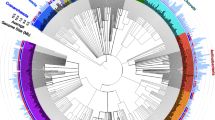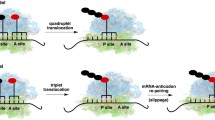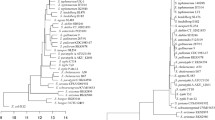Abstract
Transversion and transition mutations have variable effects on the stability of RNA secondary structure considering that the former destabilizes the double helix geometry to a greater extent by introducing purine:purine (R:R) or pyrimidine:pyrimidine (Y:Y) base pairs. Therefore, transversion frequency is likely to be lower than that of transition in the secondary structure regions of RNA genes. Here, we performed an analysis of transition and transversion frequencies in tRNA genes defined well with secondary structure and compared with the intergenic regions in five bacterial species namely Escherichia coli, Klebsiella pneumoniae, Salmonella enterica, Staphylococcus aureus and Streptococcus pneumoniae using a large genome sequence data set. In general, the transversion frequency was observed to be lower than that of transition in both tRNA genes and intergenic regions. The transition to transversion ratio was observed to be greater in tRNA genes than that in the intergenic regions in all the five bacteria that we studied. Interestingly, the intraspecies base substitution analysis in tRNA genes revealed that non-compensatory substitutions were more frequent than compensatory substitutions in the stem region. Further, transition to transversion ratio in the loop region was observed to be significantly lesser than that among the non-compensatory substitutions in the stem region. This indicated that the transversion is more deleterious than transition in the stem regions. In addition, substitutions from amino bases (A/C) to keto bases (G/T) were also observed to be more than the reverse substitutions in the stem region. Substitution from amino bases to keto bases are likely to facilitate the stable G:U pairing unlike the reverse substitution that facilitates the unstable A:C pairing in the stem region of tRNA. This work provides additional support that the secondary structure of tRNA molecule is what drives the different substitutions in its gene sequence.






Similar content being viewed by others
Data Availability
The data underlying this article will be shared on request to the corresponding author S. S. Satapathy.
Code Availability
Not applicable.
References
Abdullah T, Faiza M, Pant P et al (2016) An analysis of single nucleotide substitution in genetic codons-probabilities and outcomes. Bioinformation 12:98
Abe H, Aiba H (1996) Differential contributions of two elements of rho-independent terminator to transcription termination and mRNA stabilization. Biochimie 78:1035–1042
Agris PF (2008) Bringing order to translation: the contributions of transfer RNA anticodon-domain modifications. EMBO Rep 9:629–635
Agris PF, Narendran A, Sarachan K et al (2017) The importance of being modified: the role of RNA modifications in translational fidelity. Enzyme 41:1–50
Bao C, Loerch S, Ling C et al (2020) mRNA stem-loops can pause the ribosome by hindering A-site tRNA binding. Elife 9:e55799
Chewapreecha C, Marttinen P, Croucher NJ et al (2014) Comprehensive identification of single nucleotide polymorphisms associated with beta-lactam resistance within pneumococcal mosaic genes. PLoS Genet 10:e1004547
Duchêne S, Ho SYW, Holmes EC (2015) Declining transition/transversion ratios through time reveal limitations to the accuracy of nucleotide substitution models. BMC Evol Biol 15:1–10
Fersht AR, Knill-Jones JW (1981) DNA polymerase accuracy and spontaneous mutation rates: frequencies of purine. purine, purine. pyrimidine, and pyrimidine. Pyrimidine mismatches during DNA replication. Proc Natl Acad Sci 78:4251–4255
Frisch M, Trucks GW, Schlegel HB et al (2009) Gaussian 09, Revision d. 01. Gaussian Inc, Wallingford, p 201
Galtier N, Lobry JR (1997) Relationships between genomic G+ C content, RNA secondary structures, and optimal growth temperature in prokaryotes. J Mol Evol 44:632–636
Gojobori T, Li W-H, Graur D (1982) Patterns of nucleotide substitution in pseudogenes and functional genes. J Mol Evol 18:360–369
Grundy FJ, Henkin TM (2006) From ribosome to riboswitch: control of gene expression in bacteria by RNA structural rearrangements. Crit Rev Biochem Mol Biol 41:329–338
Gruber AR, Lorenz R, Bernhert SH, Neuböck R, Hofacker IL (2008) The Vienna RNA websuite. Nucleic Acid Res 36:W70–W74
Hall MN, Gabay J, Débarbouillé M, Schwartz M (1982) A role for mRNA secondary structure in the control of translation initiation. Nature 295:616–618
Hickey DA, Singer GAC (2004) Genomic and proteomic adaptations to growth at high temperature. Genome Biol 5:1–7
Higgs PG (2000) RNA secondary structure: physical and computational aspects. Q Rev Biophys 33:199–253
Holley RW, Apgar J, Everett GA et al (1965) Structure of a ribonucleic acid. Science 147:1462–1465
Holt KE, Wertheim H, Zadoks RN et al (2015) Genomic analysis of diversity, population structure, virulence, and antimicrobial resistance in Klebsiella pneumoniae, an urgent threat to public health. Proc Natl Acad Sci 112:E3574–E3581
Hou Y-M, Schimmel P (1988) A simple structural feature is a major determinant of the identity of a transfer RNA. Nature 333:140–145
Hudelot C, Gowri-Shankar V, Jow H et al (2003) RNA-based phylogenetic methods: application to mammalian mitochondrial RNA sequences. Mol Phylogenet Evol 28:241–252
Ishimura R, Nagy G, Dotu I et al (2014) Ribosome stalling induced by mutation of a CNS-specific tRNA causes neurodegeneration. Science 345:455–459
Jow H, Hudelot C, Rattray M, Higgs PG (2002) Bayesian phylogenetics using an RNA substitution model applied to early mammalian evolution. Mol Biol Evol 19:1591–1601
Keller I, Bensasson D, Nichols RA (2007) Transition-transversion bias is not universal: a counter example from grasshopper pseudogenes. PLoS Genet 3:e22
Knies JL, Dang KK, Vision TJ et al (2008) Compensatory evolution in RNA secondary structures increases substitution rate variation among sites. Mol Biol Evol 25:1778–1787
Kriner MA, Groisman EA (2017) RNA secondary structures regulate three steps of Rho-dependent transcription termination within a bacterial mRNA leader. Nucleic Acids Res 45:631–642
Lewis CA, Crayle J, Zhou S et al (2016) Cytosine deamination and the precipitous decline of spontaneous mutation during Earth’s history. Proc Natl Acad Sci 113:8194–8199
Libri D, Stutz F, McCarthy T, Rosbash M (1995) RNA structural patterns and splicing: molecular basis for an RNA-based enhancer. RNA 1:425–436
Lorenz R, Bernhart SH, HönerZuSiederdissen C, Tafer H, Flamm C, Stadler PF, Hofacker IL (2011) ViennaRNA package 2.0. Algorithms Mol Biol 6:26
Lowe TM, Chan PP (2016) tRNAscan-SE On-line: integrating search and context for analysis of transfer RNA genes. Nucleic Acids Res 44:W54–W57
Lyons DM, Lauring AS (2017) Evidence for the selective basis of transition-to-transversion substitution bias in two RNA viruses. Mol Biol Evol 34:3205–3215
Maiti M, Nauwelaerts K, Lescrinier E et al (2010) Self-complementary sequence context in mature miRNAs. Biochem Biophys Res Commun 392:572–576
Mann HB, Whitney DR (1947) On a test of whether one of two random variables is stochastically larger than the other. Ann Math Stat 18:50–60
Mathews DH, Disney MD, Childs JL, Schroeder SJ, Zuker M, Turner DH (2004) Incorporating chemical modification constraints into a dynamic programming algorithm for prediction of RNA secondary structure. Proc Natl Acad Sci USA 101:7287–7292
McClain WH, Foss K (1988) Changing the identity of a tRNA by introducing a GU wobble pair near the 3’acceptor end. Science 240:793–796
Montange RK, Batey RT (2008) Riboswitches: emerging themes in RNA structure and function. Annu Rev Biophys 37:117–133
Park C, Chen X, Yang J-R, Zhang J (2013) Differential requirements for mRNA folding partially explain why highly expressed proteins evolve slowly. Proc Natl Acad Sci 110:E678–E686
Pereira M, Francisco S, Varanda AS et al (2018) Impact of tRNA modifications and tRNA-modifying enzymes on proteostasis and human disease. Int J Mol Sci 19:3738
Reuter S, Török ME, Holden MTG et al (2016) Building a genomic framework for prospective MRSA surveillance in the United Kingdom and the Republic of Ireland. Genome Res 26:263–270
Rossetti G, Dans PD, Gomez-Pinto I et al (2015) The structural impact of DNA mismatches. Nucleic Acids Res 43:4309–4321
Savill NJ, Hoyle DC, Higgs PG (2001) RNA sequence evolution with secondary structure constraints: comparison of substitution rate models using maximum-likelihood methods. Genetics 157:399–411
Seplyarskiy VB, Kharchenko P, Kondrashov AS, Bazykin GA (2012) Heterogeneity of the transition/transversion ratio in Drosophila and Hominidae genomes. Mol Biol Evol 29:1943–1955
Sinha NK, Haimes MD (1981) Molecular mechanisms of substitution mutagenesis. An experimental test of the Watson-Crick and topal-fresco models of base mispairings. J Biol Chem 256:10671–10683
Stoltzfus A, Norris RW (2016) On the causes of evolutionary transition: transversion bias. Mol Biol Evol 33:595–602
Thorpe HA, Bayliss SC, Hurst LD, Feil EJ (2017) Comparative analyses of selection operating on nontranslated intergenic regions of diverse bacterial species. Genetics 206:363–376
Topal MD, Fresco JR (1976) Complementary base pairing and the origin of substitution mutations. Nature 263:285–289
Tubbs A, Nussenzweig A (2017) Endogenous DNA damage as a source of genomic instability in cancer. Cell 168:644–656
Vogel F, Kopun M (1977) Higher frequencies of transitions among point mutations. J Mol Evol 9:159–180
Wang H, Hickey DA (2002) Evidence for strong selective constraint acting on the nucleotide composition of 16S ribosomal RNA genes. Nucleic Acids Res 30:2501–2507
Wang H-C, Xia X, Hickey D (2006) Thermal adaptation of the small subunit ribosomal RNA gene: a comparative study. J Mol Evol 63:120–126
Wang J, Youkharibache P, Zhang D et al (2020) iCn3D, a web-based 3D viewer for sharing 1D/2D/3D representations of biomolecular structures. Bioinformatics 36:131–135
Wu C-I, Maeda N (1987) Inequality in mutation rates of the two strands of DNA. Nature 327:169–170
Xu X, Zhao P, Chen S-J (2014) Vfold: a web server for RNA structure and folding thermodynamics prediction. PLoS ONE 9:e107504
Zhao C, Xu X, Chen S-J (2017) Predicting RNA structure with Vfold. In: Kaufmann M, Klinger C, Savelsbergh A (eds) Functional genomics. Springer, New York, pp 3–15
Acknowledgements
We are highly grateful to anonymous reviewers and Prof. Paul Higgs for their kind suggestions that improved the quality of the manuscript significantly. We thank Dr. Harry Thrope for providing the sequence data. PS is thankful to UGC, GoI New Delhi for the JRF. SSS and SKR are thankful to DBT, GoI for the twinning Grant (BT/PR16361/NER/95/192/2015 date 18-10-2016) to them. SKR and RCD are thankful to DBT, GoI for the twinning Grant BT/PR16182/NER/95/92/2015. SSS is thankful to DBT for the NE Overseas Associateship, which helped him to work in University of Bath. EF, SSS, RCD and SKR are thankful to the society for Molecular Biology and Evolution (SMBE) for holding the satellite meeting at Kaziranga, Assam, India on Dec 14th–6th, 2017, which helped the authors to have collaboration on this work.
Funding
No funding supported for this research.
Author information
Authors and Affiliations
Contributions
PS performed the work, analyzed data; PS wrote the computer programs; RCD performed energy calculation of different base pairs; SSS and SKR designed the experiment; PS, RA, SSS, EF and SKR critically analyzed the data; PS, RA, RCD, EF, SKR and SSS wrote the manuscript. All authors have read and approved the manuscript.
Corresponding authors
Ethics declarations
Conflict of interest
No author has conflict of interest.
Additional information
Handling editor: Arturo Becerra.
Supplementary Information
Below is the link to the electronic supplementary material.
Rights and permissions
About this article
Cite this article
Sen, P., Aziz, R., Deka, R.C. et al. Stem Region of tRNA Genes Favors Transition Substitution Towards Keto Bases in Bacteria. J Mol Evol 90, 114–123 (2022). https://doi.org/10.1007/s00239-021-10045-x
Received:
Accepted:
Published:
Issue Date:
DOI: https://doi.org/10.1007/s00239-021-10045-x




